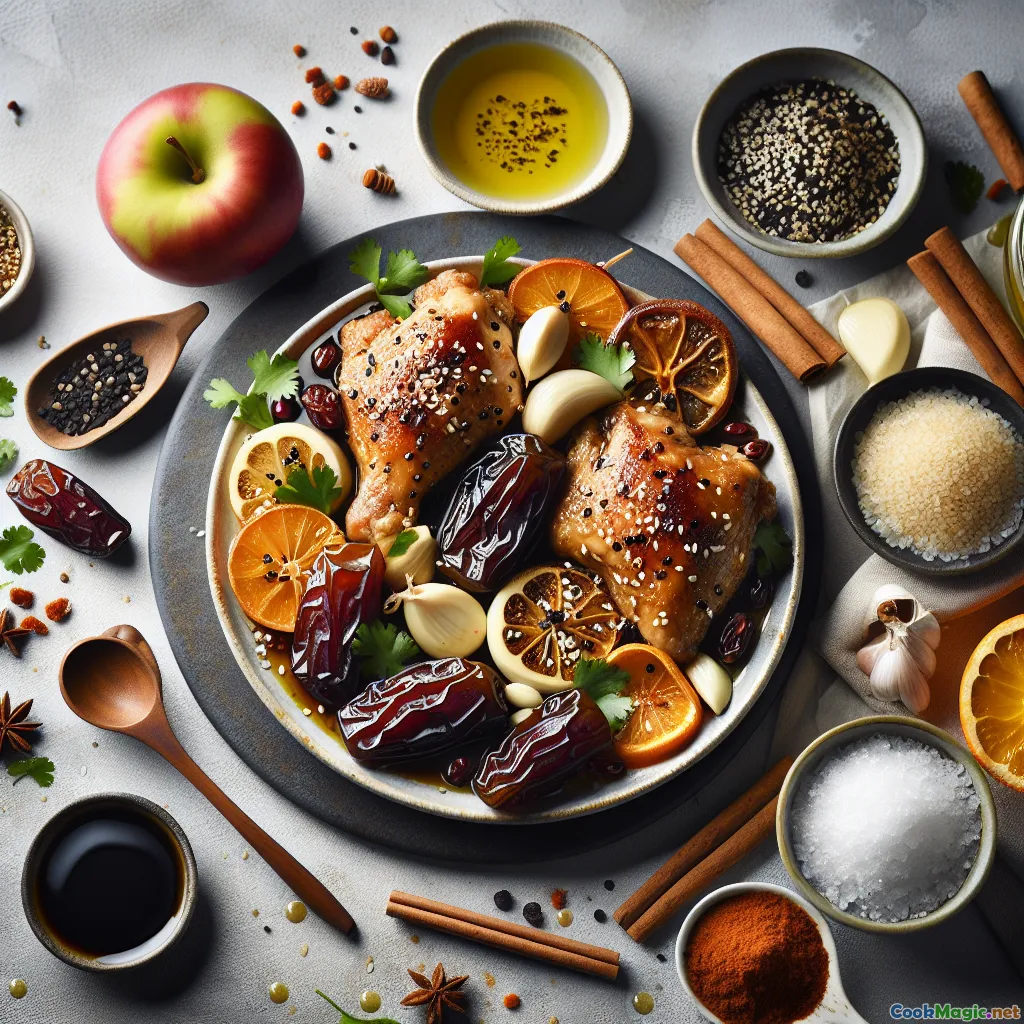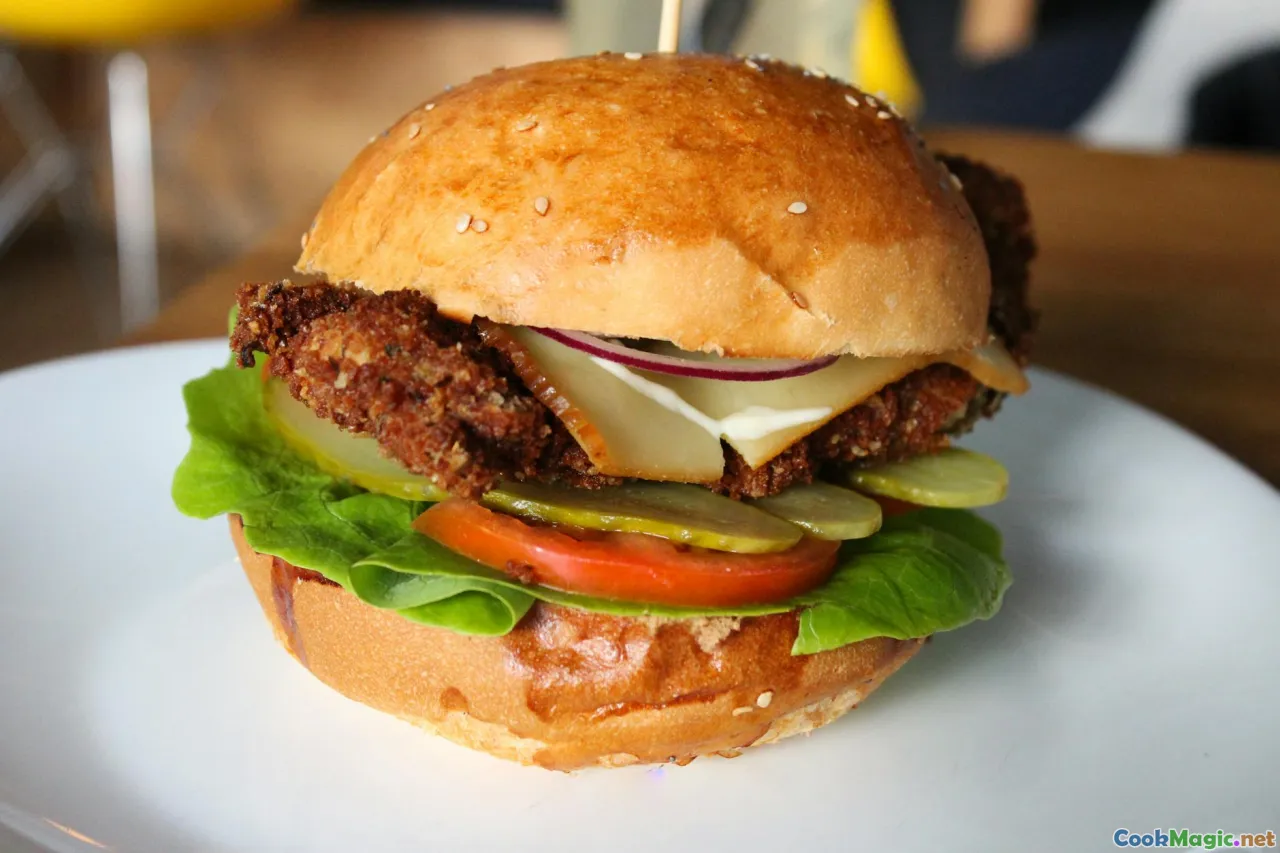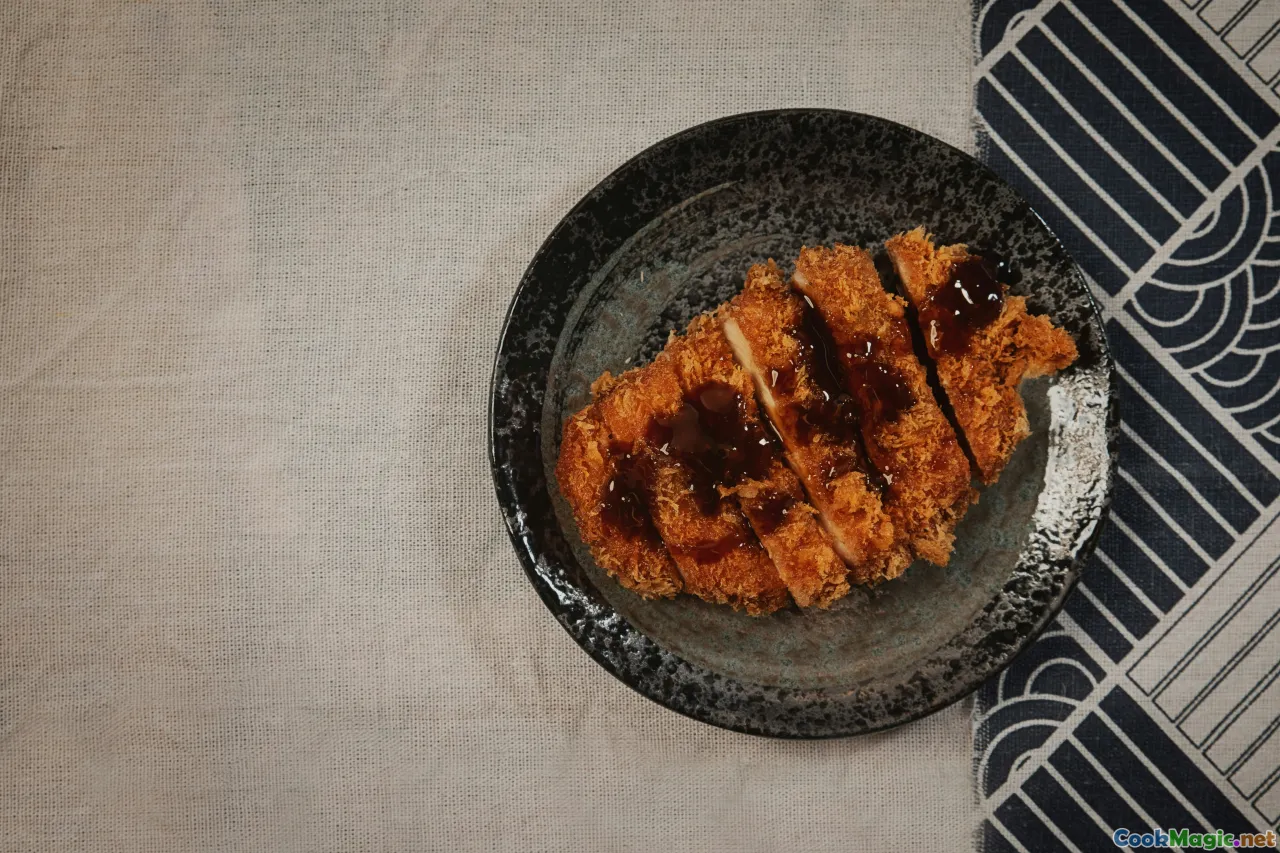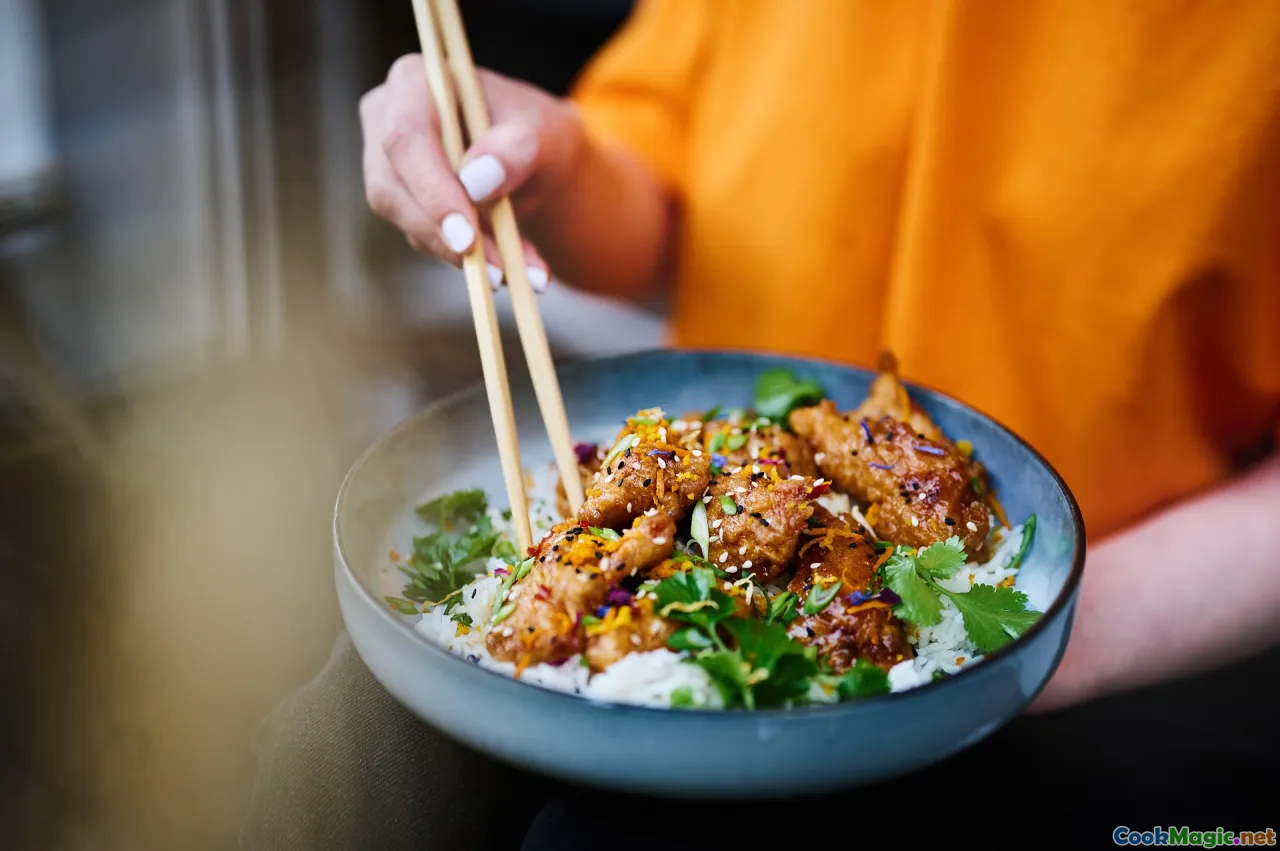
खजूर-मेलास चिकन के साथ भुना हुआ तिल ग्लेज़
(Molasses Date Chicken with Toasted Sesame Glaze)
(0 समीक्षाएँ)सामग्री
-
800 grams बोनलेस और स्किनलेस चिकन थाईज़
(Thighs stay juicier than breasts)
-
120 grams बीज निकालकर कटे हुए खजूर
(Medjool preferred for caramel sweetness)
-
3 tbsp ब्लैकस्टेप मोलास
(Use mild molasses if you prefer less bitterness)
-
3 tbsp डार्क सोया सॉस (या टामारी)
(Tamari keeps it gluten-free)
-
2 tbsp ताजा नींबू का रस
(Balances sweetness and brightens)
-
1 tbsp सेब का सिरका
(Adds tang; sub with rice vinegar)
-
1 tbsp भुने हुए तिल का तेल
(Nutty depth)
-
1.5 tbsp न्यूट्रल तेल (कैनोला या सूरजमुखी)
(For high-heat searing)
-
4 cloves लहसुन (कटा हुआ)
(Fresh garlic for punch)
-
2 tsp ताजा अदरक, घिसा हुआ
(Spicy warmth)
-
1 tsp पीस हुआ जीरा
(Earthy base note)
-
1 tsp स्मोक्ड पेपरिका
(Subtle smokiness)
-
0.5 tsp पिसा हुआ धनिया
(Citrusy lift)
-
0.5 tsp लाल मिर्च के पत्ते
(तापमान की पसंद के अनुसार समायोजित करें)
-
0.5 tsp मिश्रित समुद्री नमक
(Reduce if soy is very salty)
-
0.5 tsp ताजा पिसा हुआ काला मिर्च
(स्वादानुसार)
-
180 ml कम नमक वाला चिकन स्टॉक
(Water works in a pinch)
-
2 tsp कॉर्नस्टार्च
(Thickens the glaze)
-
2 tsp Slurry के लिए पानी
(Mix with cornstarch)
-
3 tbsp भुने हुए तिल
(Reserve 1 tbsp for garnish)
-
3 pieces हरी प्याज़, पतली कटी
(Use green parts for garnish)
-
10 grams ताजा धनिया पत्तियाँ
(Optional herb finish)
-
1 tsp संतरे की ज़ेस्ट, बारीक कद्दूकस किया हुआ
(Bright citrus aroma)
(Thighs stay juicier than breasts)
(Medjool preferred for caramel sweetness)
(Use mild molasses if you prefer less bitterness)
(Tamari keeps it gluten-free)
(Balances sweetness and brightens)
(Adds tang; sub with rice vinegar)
(Nutty depth)
(For high-heat searing)
(Fresh garlic for punch)
(Spicy warmth)
(Earthy base note)
(Subtle smokiness)
(Citrusy lift)
(तापमान की पसंद के अनुसार समायोजित करें)
(Reduce if soy is very salty)
(स्वादानुसार)
(Water works in a pinch)
(Thickens the glaze)
(Mix with cornstarch)
(Reserve 1 tbsp for garnish)
(Use green parts for garnish)
(Optional herb finish)
(Bright citrus aroma)
पोषण
- परोसने की संख्या: 4
- सेवा आकार: 1 प्लेट (300ग्राम)
- Calories: 640 kcal
- Carbohydrates: 0 g
- Protein: 34 g
- Fat: 27 g
- Fiber: 4 g
- Sugar: 27 g
- Sodium: 980 mg
- Cholesterol: 150 mg
- Calcium: 120 mg
- Iron: 4.2 mg
निर्देश
-
1 - Prep aromatics and dates:
Chop the dates, mince the garlic, grate the ginger, slice the scallions, and zest the orange. Measure all spices and liquids so cooking flows smoothly.
-
2 - Whisk the molasses-date marinade:
In a bowl, whisk molasses, soy/tamari, lemon juice, vinegar, sesame oil, garlic, ginger, cumin, smoked paprika, coriander, chili flakes, salt, black pepper, and orange zest until glossy.
-
3 - Marinate the Chicken:
Pat chicken dry. Toss with half the marinade; cover and marinate 15 minutes at room temp (or up to 12 hours refrigerated). Reserve the remaining marinade for the sauce.
-
4 - Toast sesame seeds:
In a dry skillet over medium heat, toast sesame seeds, stirring, until fragrant and golden, 2–3 minutes. Transfer to a bowl; reserve 1 tbsp for garnish.
-
5 - Sear the Chicken:
Heat neutral oil in a large skillet over medium-high. Shake excess marinade off chicken. Sear in batches until deep golden on both sides, about 3–4 minutes per side. Transfer to a plate.
-
6 - Build the Sauce Base:
Lower heat to medium. Add chopped dates to the skillet with the chicken stock and the reserved marinade. Scrape up browned bits; simmer 3 minutes to soften dates.
-
7 - Thicken the glaze:
Stir cornstarch and water to make a slurry, then pour into the simmering sauce. Cook, stirring, until the sauce turns glossy and lightly coats a spoon.
-
8 - Glaze and coat:
Return chicken and any juices to the pan. Toss to coat in the thickened sauce. Stir in 2 tbsp toasted sesame seeds and adjust seasoning to taste.
-
9 - Finish with freshness:
Off the heat, fold in most of the scallions and cilantro. The residual heat will soften them without dulling their color.
-
10 - Serve:
Plate the chicken with its sauce. Sprinkle reserved sesame seeds and remaining scallions on top. Serve with rice, couscous, or warm flatbreads.
Chop the dates, mince the garlic, grate the ginger, slice the scallions, and zest the orange. Measure all spices and liquids so cooking flows smoothly.
In a bowl, whisk molasses, soy/tamari, lemon juice, vinegar, sesame oil, garlic, ginger, cumin, smoked paprika, coriander, chili flakes, salt, black pepper, and orange zest until glossy.
Pat chicken dry. Toss with half the marinade; cover and marinate 15 minutes at room temp (or up to 12 hours refrigerated). Reserve the remaining marinade for the sauce.
In a dry skillet over medium heat, toast sesame seeds, stirring, until fragrant and golden, 2–3 minutes. Transfer to a bowl; reserve 1 tbsp for garnish.
Heat neutral oil in a large skillet over medium-high. Shake excess marinade off chicken. Sear in batches until deep golden on both sides, about 3–4 minutes per side. Transfer to a plate.
Lower heat to medium. Add chopped dates to the skillet with the chicken stock and the reserved marinade. Scrape up browned bits; simmer 3 minutes to soften dates.
Stir cornstarch and water to make a slurry, then pour into the simmering sauce. Cook, stirring, until the sauce turns glossy and lightly coats a spoon.
Return chicken and any juices to the pan. Toss to coat in the thickened sauce. Stir in 2 tbsp toasted sesame seeds and adjust seasoning to taste.
Off the heat, fold in most of the scallions and cilantro. The residual heat will soften them without dulling their color.
Plate the chicken with its sauce. Sprinkle reserved sesame seeds and remaining scallions on top. Serve with rice, couscous, or warm flatbreads.
खजूर-मेलास चिकन के साथ भुना हुआ तिल ग्लेज़ :के बारे में ज़्यादा जानकारी
Overview
Molasses Date Chicken with Sesame is a luscious, weeknight-friendly dish that brings together deep caramel notes from molasses, natural fruit sweetness from dates, and the nutty pop of toasted sesame. It is inspired by pantry traditions that stretch from the Gulf and Levant, where dates and sesame are staples, to the molasses-loving kitchens of the American South. The result is a glossy, sweet-savory glaze that clings beautifully to juicy chicken thighs, balanced with lemon brightness and a whisper of aromatic spices.
Why this recipe works
- Layered sweetness: Whole chopped dates lend body and a gentle, rounded sweetness that is different from sugar. Molasses contributes bittersweet depth, preventing the sauce from becoming cloying.
- Balanced by acidity and umami: Lemon juice and a touch of vinegar lift the glaze, while soy or tamari adds savoriness and a bronzed color.
- Texture and aroma: Toasted sesame seeds bring a crackly contrast and a roasty aroma that complements the dates.
- Smart technique: Searing chicken first builds fond; deglazing with stock and reserved marinade pulls those flavors into the sauce. A quick cornstarch slurry guarantees a shiny, clingy finish without long reduction times.
Ingredient notes and smart swaps
- Dates: Medjool dates are ideal for their fudgy texture, but Deglet Noor works too. If dates are very dry, soak briefly in warm stock before step 6.
- Molasses: Blackstrap delivers intensity and minerals. For a milder profile, use light molasses. Date syrup can replace part of the molasses if you want a more regional Gulf flavor.
- Soy or tamari: Tamari keeps the dish gluten-free. If you avoid soy, try coconut aminos and reduce any added salt.
- Chicken: Thighs are forgiving and remain succulent. Boneless breasts work if seared quickly and glazed gently to avoid overcooking. For a vegetarian spin, use extra-firm tofu or roasted cauliflower steaks.
- Heat and spice: Chili flakes are optional. Sumac can replace some lemon for a tangy, berry-like twist; a pinch of cinnamon nods to Levantine braises.
Technique tips
- Reserve half the marinade: This is both for flavor concentration and food safety. The reserved portion never touches raw chicken and becomes the base of your sauce.
- Toast sesame seeds just until fragrant: They can burn quickly; pull them off the heat the moment they turn golden.
- Manage the glaze: Cornstarch thickens rapidly. Add the slurry gradually while the sauce simmers, stirring constantly, until it lightly coats a spoon. If it tightens too much, splash in stock or water.
- Fond is flavor: Those browned bits after searing are culinary gold. Scrape them up when you add stock in step 6.
Serving and pairing
This chicken shines with steamed jasmine rice, buttered bulgur, pearled couscous, or fluffy freekeh. A crisp side like cucumber and herb salad or shaved fennel with lemon offsets the gloss of the glaze. Warm flatbreads make an excellent vehicle for scooping sauce and chicken. For beverages, try mint tea, a citrusy spritzer, or a light-bodied red with chill.
Make ahead, storage, and meal prep
- Marination: The chicken can marinate up to 12 hours in the refrigerator. If marinating longer than 30 minutes, reduce added salt slightly to prevent curing.
- Refrigeration: Leftovers keep 3 to 4 days. The sauce thickens when cold; loosen with a spoonful of water while reheating over low heat.
- Freezing: Freeze in a shallow container for up to 2 months. Thaw overnight in the fridge and rewarm gently to preserve the glaze.
Cultural notes
Dates and sesame are pillars of Middle Eastern pantries, often appearing in sweets like date cookies, sesame halvah, and nut-studded confections. Molasses, though familiar in American baking, also intersects with regional syrups such as date molasses and grape molasses used across the Levant and North Africa. This recipe merges those traditions into a savory skillet dish, making something that tastes both comfortingly familiar and intriguingly new.
Variations to explore
- Pomegranate spark: Replace half the lemon juice with pomegranate molasses for tart fruitiness.
- Smoky grill: Grill the marinated chicken over medium-high heat, then toss with the hot, thickened sauce and sesame.
- Orange-forward: Double the orange zest and add a squeeze of juice at the end for perfumed brightness.
- Nutty crunch: Add toasted chopped pistachios or almonds with the sesame for extra texture.
- Veg-centric: Roast cauliflower florets until caramelized, then glaze them exactly as you would the chicken.
Troubleshooting
- Too sweet: Add a splash of vinegar or extra lemon; a pinch of salt can also tame sweetness.
- Too salty: Stir in a few spoonfuls of unsalted stock or water, then simmer back to a light glaze.
- Sauce too thin: Simmer 1 to 2 minutes longer or add a tiny bit more slurry.
- Sauce too thick or sticky: Loosen with warm stock and stir off heat.
- Chicken sticking: Do not flip too early; a good sear releases naturally.
Personal notes
What I love most here is the way simple pantry items converge into a sauce that feels luxurious without fuss. The scent of sesame and ginger blooming in the pan, the glossy sheen as the slurry does its quiet magic, and the jeweled bits of date clinging to the chicken all make it a dish that punches far above its effort level. It is weeknight-easy, dinner party-worthy, and endlessly adaptable to what you have on hand. Serve it family-style, let the sauce pool generously, and do not forget that last shower of sesame for crunch and aroma. Nutritional values may vary based on brands and precise quantities, but the balance of protein, gentle sweetness, and bright acidity should leave the plate wiped clean every time.

















